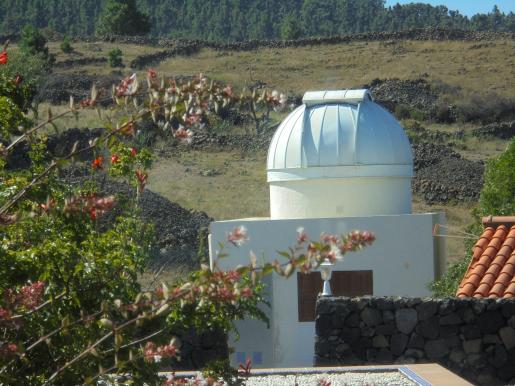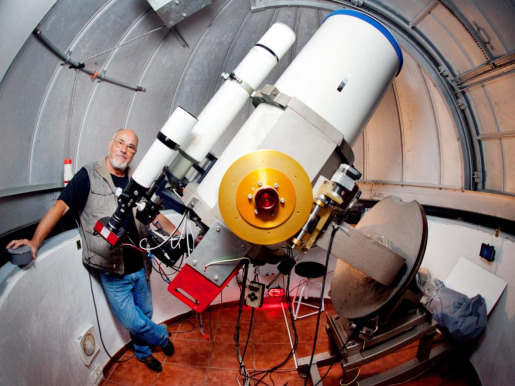The main part of the observatory consists of a comfortable rectangular building on top of which is a 3.2 metre diameter Ash dome. The dome is motorized and computer-controlled so that when in use its slit is always in front of the telescope aperture. That's the theory, anyway, but glitches do happen. Unfortunately, the slit itself can not (yet) be opened and closed under computer control so an operator must always be present when the telescope is in use. Perhaps in future the slit may be computer controlled, in which case the telescope would be operable over the internet.


Inside the dome are a number of telescopes all mounted on the same massive equatorial fork mount. The mount is, of course, computer controlled in both right ascension and declination.
The principal telescope has an aperture of 400mm, a focal length of 2614mm and is of the Dilworth-Relay design. It can be used visually when a filter-wheel and eyepiece is fitted but it is generally used for imaging with a Starlight Xpress Trius-PRO SX814 CCD camera. Between that camera and the telescope is a mechanized focuser and an 11-position filter-wheel. All of this is computer-controlled. A Bahtinov mask is used to achieve a precise focus, generally good to within a few microns of true focus.
Mounted on the same equatorially-driven fork are a 62mm finder, an Explore Scientific 80mm f/6 apochromatic refractor and a Vixen R120S refractor with an aperture of 120mm and a focal length of 800mm. It is currently used as a guide scope with a Lodestar2 guide camera. The Explore Scientific is particular useful for solar observations whereas the Vixen is better suited to wide-field imaging.
Incidentally, the chap in the photo is Joan Genebriera, from whom I bought Tacande Observatory.
In the summer of 2024 work began on a roll-off-roof observatory. The building was completed six months later but as of July 2025 it doesn't contain any usable equipment. Commissioning will begin in August of this year. At present a Meade 250mm Schmidt-Newtonian telescope, a pillar-mounted EQ-8 equatorial head, and a Moravian G2 8300 camera with integrated 5-slot filter wheel have been acquired.
When completed this observatory will be fully automated and controllable from anywhere in the world over the internet.